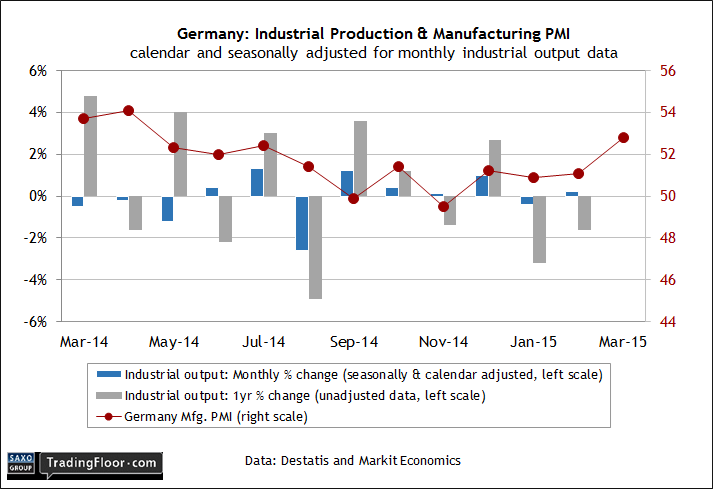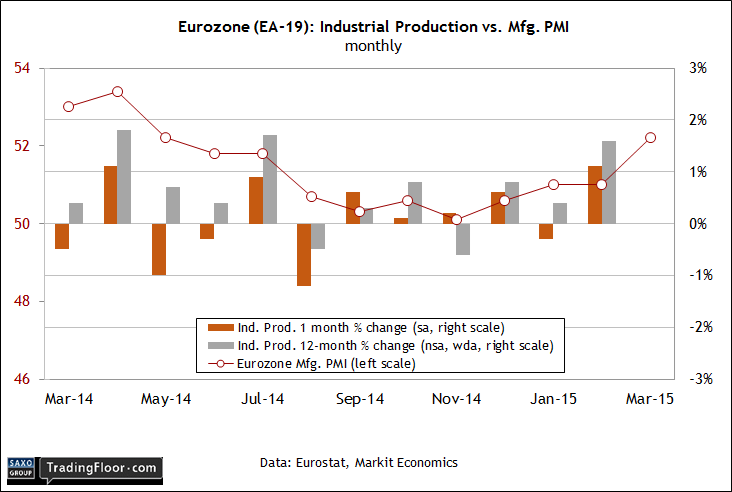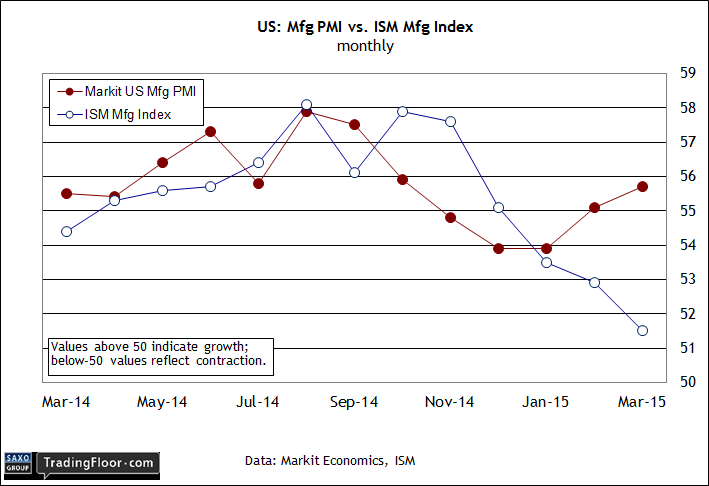An early look at the macro profile for the start of the second quarter is the main event today for Europe and the US via flash estimates of purchasing managers indexes (PMI) for April. At stake are two key macro questions: Is the Eurozone’s mild recovery still intact and what are the odds that the US economy’s first quarter weakness was just a temporary blip that will give way to a revival in growth in Q2?
Germany: Manufacturing PMI (07:30 GMT) Europe’s biggest economy is growing at a healthy pace, although industrial activity has been soft lately. Is this a warning of trouble ahead? No, according to survey data for manufacturing. Markit’s purchasing managers index (PMI) for the sector rose to an 11-month high in March. Companies expanded their workforces as new order and output accelerated, Markit advised.
The weak profile in the hard data for industrial activity conflicts with the upbeat PMI numbers. But if today’s flash estimate for April holds on to last month’s advance, the odds will continue to favour projections for a solid pace of growth for Germany’s macro trend.
"Strong tailwinds from a robust labour market, low oil prices and a competitively priced exchange rate, as well as the reform successes in countries such as Spain, are propelling the German economy forward,” a Berenberg Bank economist noted this week.
Today’s initial estimate of the manufacturing PMI is expected to support the case for optimism. Econoday.com’s consensus forecast sees the index ticking higher to 53.0 for April from 52.8 in March. In other words, a moderate growth rate remains the crowd’s outlook for manufacturing, a key sector for Germany’s export-driven economy.

Eurozone: Manufacturing PMI (08:00 GMT) An early clue on the survival odds for the Eurozone’s recovery is in focus with today’s flash data on sentiment in the manufacturing sector across the currency bloc. Recent history for this indicator suggests that growth has a moderate tailwind via this cyclically sensitive slice of macro activity. The Markit Eurozone Manufacturing PMI inched higher in March, touching a 10-month high of 52.2.
The hard numbers for industrial activity offer support as well. According to Eurostat, output accelerated in February. The month and annual comparisons increased at the strongest rates since last summer, suggesting that Europe’s industrial trend has turned a corner.
Reuters yesterday reported that the Eurozone economy is on a “sustainable recovery path,” according to a majority of economists recently polled by the news organiSation. “Gross domestic product growth is expected to average a steady 0.4% per quarter until mid-2016, giving a 1.4% annual rate this year and 1.6% in 2016,” Reuters reported. “Although those numbers are largely unchanged from the March poll, 23 of 55 common banks who participated in both surveys moved annual predictions higher.
Today’s update of the manufacturing PMI will provide a reality check for the recent improvement in macro expectations. For the moment, the future still looks encouraging, based on Econoday.com’s consensus forecast. Economists anticipate the flash reading for the manufacturing PMI will tick up to 52.6 from 52.2 in March. Roaring growth is nowhere in sight, but a steady if modest recovery still looks like a reasonable view.

US: Manufacturing PMI (13:45 GMT) US growth all but faded from view in the first quarter, according to the Atlanta Fed’s current estimate for next week’s Q1 GDP report. Economic growth is on track for an incremental rise of just 0.2 percent in the first three months of this year against the previous quarter, according to the bank’s GDPNow data. The forecast is sharply below the 2.2% rise in last year’s Q4, which was well below Q3’s gain. Macro momentum, in short, is wilting.
The first quarter may be a disappointment, but a number of analysts say that a rebound is coming in Q2. Yesterday’s stronger-than-expected gain in existing home sales for March certainly provide a bullish contrast with the gloomy numbers that have otherwise dominated the news flow in recent weeks. Demand for housing increased to its highest annual rate in 18 months last month, according to the National Association of Realtors. "After a quiet start to the year, sales activity picked up greatly throughout the country in March," the group’s chief economist said.
Is the good news a sign that we’ll see stronger numbers generally for this quarter’s macro profile? An early clue arrives in today’s flash data for manufacturing via Markit’s PMI. This indicator has been on the rise for several months and today’s update is on track for more of the same. Econoday.com’s consensus data points to another rise, pushing the April PMI to 56.0 vs. 55.7 in the previous month.
Note, however, that the competing ISM Manufacturing Index has been sliding since last November, falling to 51.5 in March - close to the neutral 50.0 mark that separates growth from contraction. One of these sentiment metrics is misleading us. It’s unclear which benchmark will blink first, but if today’s PMI update for April holds on to its recent gains or rises further, we’ll have a new reason to doubt the ISM’s dark forecast.

Disclosure: Originally published at Saxo Bank TradingFloor.com
